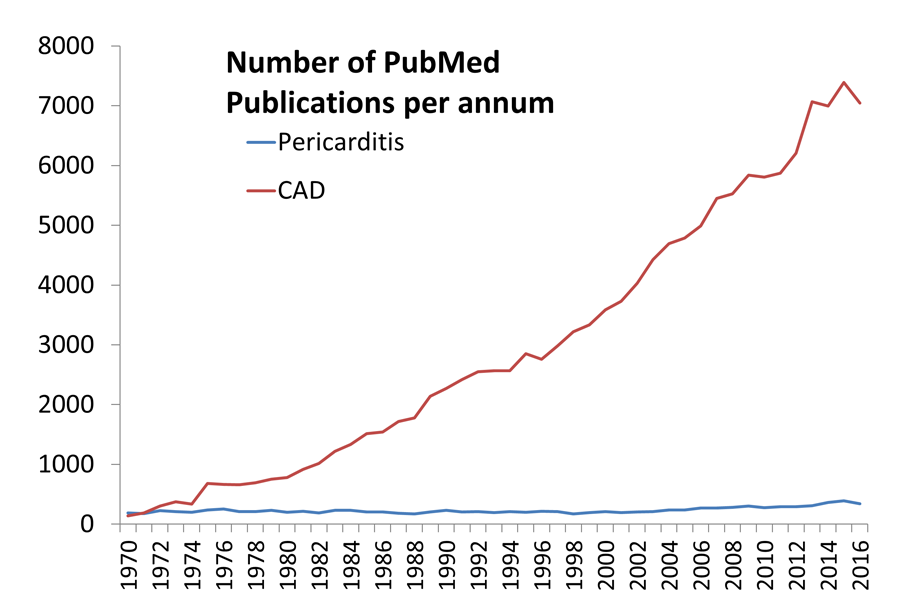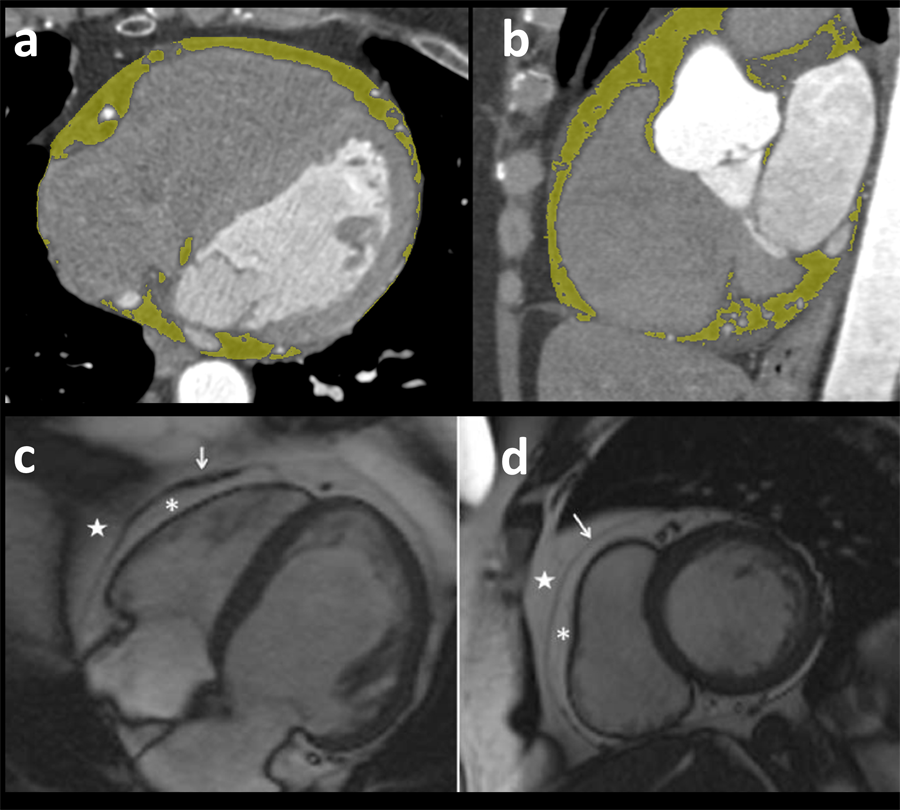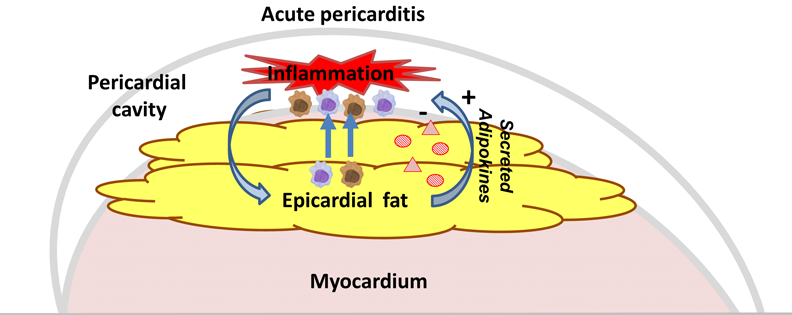Epicardial Fat in Pericarditis
Despite the recent advances in diagnostic imaging modalities and therapeutic strategies, pericarditis recurrences remain one of the main problems for the long term clinical outcome of patients after a first episode of acute pericarditis. Failure to relieve symptoms with first-line treatment, i.e., aspirin or non-steroidal anti-inflammatory drugs, may be as high as 15%, and risk of pericarditis relapse is estimated at approximately 15-30%, with specific patient subgroups being at much higher long term risk.1 Despite the familiarity of the medical community with the epidemiology of acute pericarditis, overall clinical research in the field is not following the current trends of research on other clinical entities, e.g. on coronary artery disease (Figure 1). As a result, several issues in pericarditis pathophysiology, as well as determinants of prognosis after a first episode of acute pericarditis, remains poorly explored.
Figure 1
To date, several factors have been linked with poor outcomes after acute pericarditis, such as lack of response to aspirin or NSAIDs after at least one week of therapy, corticosteroid use (which although are very effective in relieving symptoms, may potentiate recurrences), persisting CRP elevation, and the non-use of colchicine.2
Recently we demonstrated that epicardial fat volume is also an independent predictor of the long term outcome of patients with acute pericarditis.3 In a cohort of 50 patients with acute pericarditis that were followed up prospectively for 18 months for pericarditis complications, epicardial fat volume measured at baseline by cardiac computed tomography was independently associated with the risk of pericarditis recurrence (per 20cm3 increments in epicardial fat volume, OR = 0.802, 95% CI: 0.656-0.981). This is the first evidence suggesting a link between epicardial fat volume and acute pericarditis. While these findings should be interpreted with caution given the small sample size of the study, a common pathophysiologic link seems plausible.
The evolutionary role of epicardial fat has been traditionally considered to be the mechanical cushioning of the heart and coronaries, the thermal insulation of the heart and the hosting of ganglia for its innervation.4 However, recent evidence suggests that there may be more to it. For example, ectopic adiposity and accumulation of epicardial fat follows obesity phenotypes. Epidemiological evidence also suggests that the volume of epicardial fat is an independent risk factor for atrial fibrillation development, as well as for coronary atherosclerosis.4 In our recent translational studies on human adipose tissue we have demonstrated that there is a cross-talk between the heart/coronaries and epicardial fat. For example, epicardial adipose tissue responds to signals coming from the myocardium (e.g., oxidative stress products), altering its gene expression profile to lower myocardial oxidative stress.5 Similarly, we recently showed that perivascular fat surrounding inflamed coronary arteries contains smaller and less differentiated adipocytes as a result of the local inflammation process, which can be tracked by application of a novel imaging methodology.6
In a similar way, epicardial fat could actively participate in the pathophysiology of acute pericarditis given its close anatomical affinity with the pericardium. Inflammation of the pericardial sac could be regulated by adipokines secreted by epicardial fat. Indeed, our study provided the first evidence for a link between epicardial fat and acute pericarditis.3 The following explanations can be given for this finding:
i. Epicardial adipose tissue phenotype as a marker of pericardial sac inflammation
Non-invasive imaging of epicardial fat and measurement of its mass (volume) serves as a surrogate marker for epicardial fat biology, which cannot be easily studied. Currently, the quantification of epicardial fat volume can be reliably and easily performed by post-processing of computed tomography (CT) or cardiac magnetic resonance (CMR) images in dedicated workstations (Figure 2). A plausible hypothesis for the observed association between epicardial fat volume and pericarditis outcome is that in the setting of a potent local inflammatory response, as in acute pericarditis, epicardial fat adipocytes are de-differentiated. This hypothesis is backed up by our recent observations on human adipocytes: culture of adipocytes with pro-inflammatory cytokines prevents gene expression of adipose tissue differentiation markers and the intracellular accumulation of lipid droplets.6 Moreover, human perivascular adipocytes that are exposed to vascular inflammation in-vivo have a similar gene expression profile and contain small lipid droplets. These observations imply that lower epicardial fat volume could be associated with pericarditis recurrence because it indirectly flags the local inflammation of pericardium, which may have been initiated well before the clinical manifestation of acute pericarditis syndrome (e.g., development of chest pain, fever, and pericardial effusion). Besides, local inflammation cannot be reliably estimated by circulating levels of pro-inflammatory markers (e.g., C-reactive protein or interleukin-6), which do not correlate with local processes at tissue level, rendering novel biomarkers of tissue inflammation indispensable. Thus the imaging of epicardial fat could have a role as a biomarker for the diagnosis or monitoring of pericardial diseases by being a sensitive marker of pericardial inflammation. If this hypothesis holds water, then changes in epicardial fat phenotype could be detectable by non-invasive imaging before the clinical manifestation of pericardial disease.
Figure 2
ii. Regulation of pericardial sac inflammation by secreted adipokines or immune cells hosted in epicardial adipose tissue
Apart from having a role as a diagnostic or prognostic biomarker, epicardial fat could be also causally linked with pericardial sac inflammation and therefore constitute a rational therapeutic target against pericardial diseases. Secretory products of epicardial fat could be responsible for the initiation and the regulation of pericarditis-related inflammation.4 This is plausible given the role of adipose tissue in immunometabolism and the plethora of immune cells (M1/M2 macrophages, CD4+ and T-helper cells, etc.) hosted in the stromal vascular fraction of human adipose tissue.4 Indeed epicardial fat could be the gateway via which inflammatory cells migrate to the pericardial cavity, and contribute to pericarditis development. Thus in a radical re-appraisal of acute pericarditis syndrome, the latter could be considered a disease of epicardial adipose tissue, completely changing our notion of this clinical entity. Another less appealing theory is that the fat phenotype associated with a low epicardial fat volume could serve as a favorable (anatomical, endocrine or immunological) milieu for the perpetuation of the inflammation of the adjacent pericardial sac. These concepts are schematically summarized in Figure 3.
Figure 3
Future Perspectives
Unfortunately, to date experimental or clinical studies in this field are scarce. Given the translational outlook of epicardial adipose tissue as an active player in cardiac disease pathogenesis and the robust epidemiological evidence supporting a role of epicardial fat as a risk factor for atrial fibrillation or coronary atherosclerosis, its possible role in pericarditis pathogenesis cannot be overlooked. Future studies should further explore the role of epicardial fat in pericardial disease pathogenesis. The establishment of links between epicardial fat and pericardial diseases is expected to have important ramifications for the diagnosis, monitoring and therapeutic approach of patients with pericardial diseases and the findings of future research in the field are long anticipated.
References
- Cremer PC, Kumar A, Kontzias A, et al. Complicated pericarditis: understanding risk factors and pathophysiology to inform imaging and treatment. J Am Coll Cardiol 2016;68:2311-28.
- Adler Y, Charron P, Imazio M, et al. 2015 ESC Guidelines for the diagnosis and management of pericardial diseases: The Task Force for the Diagnosis and Management of Pericardial Diseases of the European Society of Cardiology (ESC) endorsed by: The European Association for Cardio-Thoracic Surgery (EACTS). Eur Heart J 2015;36:2921-64.
- Lazaros G, Antonopoulos AS, Oikonomou EK, et al. Prognostic implications of epicardial fat volume quantification in acute pericarditis. Eur J Clin Invest 2017;47:129-36.
- Antonopoulos AS, Antoniades C. The role of epicardial adipose tissue in cardiac biology: classic concepts and emerging roles. J Physiol 2017;595:3907-17.
- Antonopoulos AS, Margaritis M, Verheule S, et al. Mutual regulation of epicardial adipose tissue and myocardial redox state by PPAR- γ/adiponectin signalling. Circ Res 2016;118:842-55.
- Antonopoulos AS, Sanna F, Sabharwal N, et al. Detecting human coronary inflammation by imaging perivascular fat. Sci Transl Med 2017;9.
Keywords: Coronary Artery Disease, Adiposity, C-Reactive Protein, Interleukin-6, Anti-Inflammatory Agents, Non-Steroidal, Aspirin, Pericardial Effusion, Risk Factors, Atrial Fibrillation, Adipokines, Cytokines, Colchicine, Oxidative Stress, Transcriptome, Macrophages, Pericardium, Pericarditis, Chest Pain, Adipose Tissue, Inflammation, T-Lymphocytes, Helper-Inducer, Obesity, Myocardium, Biomarkers, Adipocytes, Tomography, X-Ray Computed, Antigens, Differentiation, Magnetic Resonance Spectroscopy, Ganglia, Phenotype, Tomography, Adrenal Cortex Hormones
< Back to Listings



